Improve Your Wildlife Photography with Patrick Ryan McCann | Khloe Kardashian | The Open
Wildlife photography depicts creatures in their native habitats, such as a forest or underwater. As a result, photos of animals in action, such as eating, fighting, or flying, are commonly utilized in wildlife photography. Mammals, insects, reptiles, plants, rodents, and other invertebrates are mammals.
It may also save details on an animal's appearance or interaction with its surroundings. As a result, Patrick Ryan McCann believes that a prospective wildlife photographer must be well-versed in an animal's behavior, surroundings, and physical characteristics.
You must also be knowledgeable in advanced photographing techniques and equipment.
Take note of your subject's eyes.
The eyes are the first thing the audience notices in a photograph. As a result, they must be sharp enough to catch the viewer's attention. As a result, you must concentrate on your subject's eyes. When an animal is moving, you can focus on the area closest to the eye. This approach can also bring your subject's eyes into focus.
Use the Rule of Thirds to help you balance your images.
The rule of thirds, for example, is a compositional principle that can help you arrange your image in a way that appeals to your viewer. Fit your photo into a three-by-three grid, with the essential parts at the grid points and the linear elements running along the grid lines. In the figure below, for example, the elephant's head is positioned on one of two top intersections to provide a balanced appearance.
Make Use of Negative Space to Draw Your Audience's Attention
Although wildlife photography is a terrific method to fill your frame, Patrick Ryan McCann suggests paying attention to your image's background. The viewer's attention will be directed to your issue if you choose a good environment. As a result, you can use a negative space background, such as a beautiful greenwash from adjacent plants or a lovely, neutral white sky. These backdrops will assist you in creating an eye-catching image.
Bring Animals to the Location of Your Choice
You may have prepared a place to capture your subject as a photographer. Patrick Ryan McCann recommends attracting the animal or bird to the desired location to carry out your plan. If you want a bird to come to a piece of log, for example, you can set up a setup with food or water to draw your subject and photograph them.
Take note of predetermined shooting times and golden hours
The golden hour occurs around an hour before and after sunset. During golden hours, the surrounding light is soothing and inviting, making it an ideal setting for animal photography. Your photographs appear more elegant and appealing since your camera balances the warmer tones.
Exercise Mindfulness
Regardless matter how thoroughly you research your subject, if you become distracted and shift your concentration away from the viewfinder, you may miss a critical moment. As a result, be vigilant until the necessary time is recorded.
You can make yourselves invisible to wildlife by using blinds.
When you go undetected without a spark of sight or sound, the substance of your images emerges. Patrick Ryan McCann suggests kneeling and laying flat on the ground, going forward and backward slowly without deviating from your subject. You can buy the right photographer blinds or make your own by cutting a few holes in an old tent.
The animal will disregard you because these are commonly hidden. Place these blinds in the area you wish to photograph before using them to give the animals time to adjust.
Make Use of the Proper Camera Settings and Techniques
You can create a spectacular shot that will leave an indelible impact on your viewers. Patrick Ryan McCann recommends keeping the settings for your environment, subject, and light handy when you're ready to shoot. Emotions can also be imaginatively represented using photography technologies.
https://issuu.com/patrickryanmccann/docs/patrick_ryan_mccann_-_ppt2.pptx_33bb2fad6ff137
https://www.facebook.com/patrickryanmccann


Comments
Post a Comment